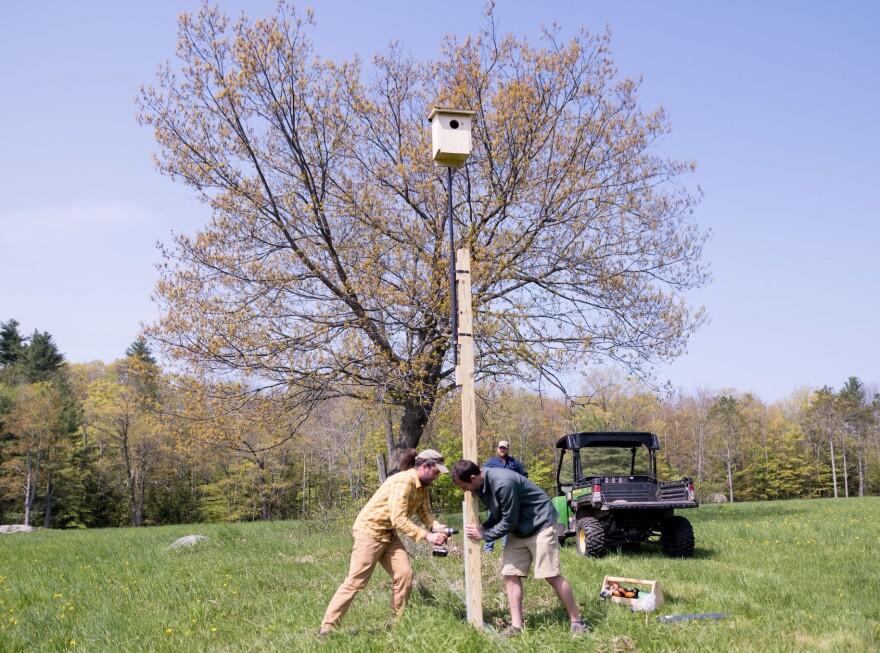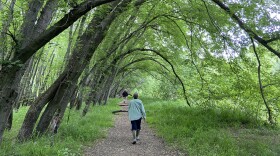Drive down a narrow farm road anywhere in the Connecticut River valley, and you might just see a colorful American kestrel, North America's smallest falcon perched on a wire and twitching its tail.
In 2022, the Harris Center for Conservation Education launched a project aimed at conserving America’s smallest falcon, the American Kestrel, a species of special concern in New Hampshire. The species has declined over 60% since the 1960s.

“I wish that was the case, that you would see a kestrel every time you drive down a farm road. But we're finding that's not the case anymore,” says Phil Brown, director of bird conservation at the Harris Center. He spearheads the Harris Center’s Kestrel Conservation Project, hoping to reverse the negative trend.
By installing and monitoring kestrel nest boxes throughout the Monadnock Region, the Harris Center hopes to bolster local kestrel populations and highlight the importance of grassland habitat.
“There still seems to be ample habitat,” Brown says. “And to see empty open fields where kestrels should be, in theory, is a little bit troublesome. A lot of kestrel biologists have noticed this over the years, and are taking steps now to try to reverse that decline by putting up nest boxes.”
Kestrels seem to be hit by a lot of different factors, such as habitat decline and the decline of large insects, which is a big part of their diet, especially when kestrels are young.
“They need to learn how to forage on prey. They are carnivores,” says Brown. “They have to eat small insects, larger insects, mammals, but they probably start with grasshoppers a lot of the time. And it's no surprise to anybody that large insects have been declining over the decades.”
American Kestrels are small birds, a little bigger than a blue jay. They have long, slender wings, which is helpful to distinguish them when they're flying.
Kestrels can be found in open habitats. In general they prefer for nesting hay fields, pasture land, especially where there are cattle. Airports are great places to find them.

There are two ways that they hunt, according to Brown. “By hovering, staying in place in the air, essentially flapping their wings backwards, they can keeping their vision focused on whatever it is they're looking for or looking at.”
Brown says kestrels have a “superpower:” they're able to see in ultraviolet (UV) light, The fresh urine trails of voles and other small field creatures are essential glowing in UV, revealing invisible prey "highways" and increasing their chances of a successful hunt.
They also eat a lot of large insects. “Dragonflies is probably the most common thing that I see in the nest boxes when I monitor them,” Brown says. “Dragonfly wings don't break down as quickly and they don't get eaten by the small birds in the nest.”
“They snatch them right out of the air,” says Brown, who’s seen it happen when watching kestrel boxes in the summer, as well as during migration. “We've been watching kestrels recently at Pack Monadnock in Peterborough, and sometimes they take time out of their active migration to grab an insect snack on the way.”
Kestrels are “secondary cavity nesters,” meaning they breed in cavities, often in trees along the forest edge, but they don't make their own hole.
“They don't have a woodpecker bill,” says Brown. “They can't excavate in wood the same way they have this raptor bill for ripping things apart. So they have to take advantage of existing cavities that larger woodpeckers would have made. Pileated and northern flicker would be the two woodpeckers around here that would make a hole that big.”
You may have a bluebird box in your garden, but a kestrel box is significantly larger than an average bluebird box.
“They have a three inch diameter hole, first of all,” Brown says. “You might think of bluebirds as having about a 1 ¼- to 1 ½-inch hole. Kestrals need one twice the diameter. They kestrel boxes are also much taller, about 16 inches in height. They have a 9-10 inch floor space, and are 8 to 20 feet high.”

Brown says kestrels are particular about their habitat. “You need a field for them to live in, but there need to be trees close by that they can nest in – but not too many trees,” Brown says. “It's a fine balance. Kestrels are are picky in that way.”
The Harris Center has worked with 49 different landowners to install nest boxes throughout 20 towns in the Monadnock region.
“It's been pretty amazing to see the level of joy that people have when they do know that they have a nesting kestrel, and then get to get to see that bird when we're doing the banding, Brown says. “It's a great responsibility for landowners, and it brings them great joy when they do successfully fledge.”
New Hampshire is just one of the eleven Northeast states with a nest box program to try to bring back kestrels, one box at a time.
Something Wild is a joint production of the Forest Society, NH Audubon and NHPR.











